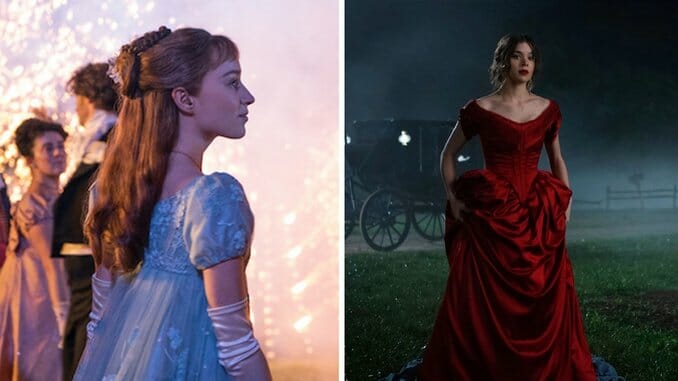Bridgerton, Dickinson, and the Unbridled Joy of Anachronistic Soundtracks

It’s the perfect scene: two young lovers dash into the night, breathless, laughing as they abandon the real world together. Tonight marks the first night of their honeymoon, and for a couple living in Regency-era London, it’s a freeing experience for the both of them. The skies open, soaking the couple’s fine evening wear. Again, they laugh. As they waltz into a stone pavilion, sheltered from the rapture, a sweeping arrangement of strings embraces their adoration. The melody, however, is no suite by Bach. Nor is it a concerto from Vivaldi, or from any composer that would fit a 19th-century England setting. The song that wraps these lovers together is by Taylor Swift, a cover of a song called “Wildest Dreams” from her 2014 album 1989.
This music genre, 21st-century pop, is not usually matched with period dramas. Period dramas prefer to make their gowned ladies bob to string arrangements from the time period, or, at the very least, scores that sound like they’d be from the time period. Never are they given the chance to twirl to Ariana Grande, be swept off their feet to Taylor Swift, or kick it with Billie Eilish—until shows like Bridgerton and Dickinson. In comparison to the litany of period pieces that have come before these two recent series, the decision to include an anachronistic soundtrack may sound radical, unearthly, or even repulsive. But when handled with grace, as both shows do, these soundtracks can lure us into the world of characters that feel the furthest from us.
Sofia Coppola’s luxuriously gauche Marie Antoinette tried to popularize this idea of anachronistic music in 2006. A lot of folks hated it: on discussing the music, like the costumes and the production design, Time Out said the soundtrack was “hip—but never history.” The AV Club argued the soundtrack felt “shoehorned in.” By adding Bow Wow Wow and New Order to Antoinette’s story, like tossing a pair of lilac Chuck Taylor’s in her closet, Coppola had devised some radical idea that could erase history. While she had certainly taken a risk, it didn’t seem to pay off to those who watched it upon release—even though it should have. Coppola’s soundtrack was loaded with hits galore, giving us a cinematic side to Antoinette that, while not by-the-books, was filled with coquettish fun.
Thankfully, a second chance came with Netflix’s Bridgerton, released 15 years later, accompanied by the same color palette and gaudy interiors. In the show’s first episode, the orchestra plucks out Ariana Grande’s seminal “Thank U, Next,” remixing the spectacles of 1813 with a smashing 2010’s twist. As the swarms of pearly-dressed guests roll into the very first ball of the season, the Vitamin String Quartet rendition of the pop tune escorts them. Now, I’d be hard pressed to believe that Daphne Bridgerton had any stakes in the Pete Davidson drama surrounding the release of “Thank U, Next,” but no song could encapsulate her dismissive tone towards those vying for her affection better than Grande’s. As she shifts from suitor to suitor, growing more and more displeased with their affections, her sentiments parallel the song with striking similarity.
Bridgerton isn’t based on a true story. It isn’t anything close to a history lesson like Marie Antoinette (then again, is Marie Antoinette really a history lesson?). Those critiques of Coppola’s film, that it was “hip—but never history,” would not apply here, because the show never aims for history. Bridgerton is a fictional romance in Regency-era London, which still, apparently, could restrict it to music made only pre-1800s tunes. But in using contemporary songs steeped in flirtation, still dripping with hot gossip, Bridgerton likens its characters to its audience. There’s little to match the girlish wave of exhilaration after that first needle drop in Bridgerton—“Oh my gosh, is this Ariana Grande?”—and the building anticipation of which pop song could come next.